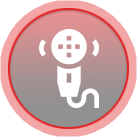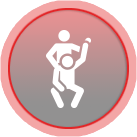Dry Needling: Release Tension For Deep Healing
Knotted areas within the muscles are known as trigger points. Caused by injured or overused muscles, trigger points are particularly sensitive and irritable and can restrict your movement and comfort. However, they also offer a unique opportunity to experience healing through dry needling.
Dry needling, which involves the placement of thin needles into trigger points for brief periods, helps to release tension in these knotted areas. Even though the needles only remain in the muscles for 10-20 seconds, they trigger a wave of physical responses that encourage healing and pain relief.
Called dry needling because this approach uses solid needles without the injection of any medication, this approach is similar to acupuncture. However, with dry needling, your provider will evaluate your pain to determine which trigger points are causing it and then focus on those locations, while acupuncture tends to involve the insertion of needles into different, less customized, areas of the body.

Why use dry needling for your healing journey
Dry Needling is transforming lives in Austin, TX. It’s an effective way to alleviate pain quickly and relieve the persistent contraction that brings about trigger point tension. Including this therapeutic technique in your sports medicine routine can pave the way for longer-lasting relief and relaxation of your muscles.
![]()
Faster Recovery
Dry needling is often capable of reducing pain after just one treatment. In addition, by relaxing the muscle, dry needling encourages the flow of blood into the muscle and the flow of toxins away from the muscle. This can also lead to a faster release of pain and an improvement in motion.
![]()
Improved Range of Motion
The tension in trigger points can hinder normal movement, especially during sports or exercise. Dry needling can release tension and reduce pain, while cupping after physical activity can alleviate soreness and enhance performance by reducing inflammation and pain from injuries and tired muscles.
![]()
Enhanced Circulation
Dry needling, by encouraging the muscles of the trigger point to relax, encourages the flow of blood and nutrients to the site. As a result, the body is better able to strengthen and heal the area so you can experience healing and pain relief deep at the source of your pain.
![]()
Toxin Removal
In addition, dry needling enables the body to remove toxins from the affected area. Often the source of pain and inflammation, the removal of these toxins helps you to feel almost immediately better and to remain feeling better after treatment ends.
Frequently Asked Questions
Want to learn more about dry needling or trigger point therapy? Check out our FAQs below!
- What is dry needling?
Dry needling is a therapeutic technique that involves inserting thing needles into sensitive, irritable bands of knotted tissue, called trigger points. This approach should only be conducted by trained and experienced healthcare professionals.
- How does dry needling work?
When the needle is inserted into the trigger points responsible for pain and dysfunction, it stimulates movement of the muscle. This movement encourages the relaxation of the muscle and increases the flow of blood through that area.
- Is dry needling the same as acupuncture?
Dry needling and acupuncture are two different techniques, even though the needles they use are similar. Dry needling targets trigger points, while acupuncture is a form of traditional Chinese medicine that focuses on balancing the energy in the body.
- What conditions can dry needling treat?
Dry needling is commonly used to treat conditions such as the following:
- Is dry needling painful?
Dry needling is usually slightly uncomfortable, but not outright painful. The procedure itself is often accompanied by a momentary twitch or cramp that gives way to the healing benefits of the approach.
- How long does a dry needling session typically last?
A dry needling session usually lasts 20-30 minutes, but can be longer, depending upon the number of trigger points being addressed and the specific needs of the patient.
- Are there any side effects or risks associated with dry needling?
Dry needling is a generally safe procedure with minimal side effects. Mild results of this procedure could include short-lived soreness, slight bleeding, mild bruising and occasionally infection. Using an experienced provider reduces your risk of serious side effects.
- How many dry needling sessions will I need?
The number of dry needling sessions you will require will depend upon your specific body and condition. One session often brings tangible relief, but multiple sessions are often required as well. Your therapist can help you determine the length of your treatment.
Today’s Top Athletes Use Dry Needling Therapy
Dry needling therapy is making waves in Austin, TX and even across professional sports leagues. Discover the testimonials of professional athletes who have experienced the transformative power of dry needling!

When discussing Dry Needling, “Some you don’t [feel], some you do if it hits a tight spot. It’ll shoot this kind of … we’ll call them zingers … It’ll shoot this like … hitting a nerve or something just shoots down your arm or your back or your leg or something like that, but it means that it’s working. But I’ll do it neck, shoulders, high back, mid back, low back, glutes, IT bands, hips, sometimes hamstrings, groin, calves, foot. It’s great.”
Drew Brees
2009 Super Bowl MVP-winning quarterback for the New Orleans Saints

“Within NCAA Division I athletes… results indicated that dry needling was effective for athletes who were exposed to dry needling. Those athletes had a decrease in muscle tightness, which enhanced their athletic performance… For exposed athletes, dry needling is an effective tool for pain management and recovery. Those exposed are in favor of future use, and recommendations to others.”
Shemeika McCray & Joni M. Boyd, PhD. CSCS*D
Perceptions of Dry Needling for Performance & Recovery in NCAA Division I Athletes

“Dry needling (DN) by athletic trainers and sports physical therapists is performed to augment recovery, prevent injury, and enhance performance… Dry needling followed by active stretching is more effective than stretching alone…Dry needling is a treatment technique that can be utilized in the care of athletes that provides many benefits… Dry needling is a treatment technique that can aid athletes in pursuing training and competing in their sporting activity.”
Todd Hooks, PT, ATC, OCS, SCS, FAAOMPTJan Dommerholt, PT, DPT
The Benefits of Dry Needling for Athletes – Myopain Seminars
More About Our Services
Ready to learn more about the services we offer? Discover all of the ways in which we can
alleviate pain, improve mobility, and support your pursuit of an active lifestyle!












